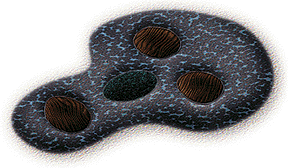
 The University of Chicago Magazine June 1996
The University of Chicago Magazine June 1996
"Things fall apart" describes a common road to death, but not our bodies' only one. An orderly demise-programmed cell death-may lie behind illnesses from Alzheimer's to AIDS. By William Burton
By William Burton
Illustrations by Allen Carroll
"Dying," observed W. Somerset Maugham, "is a very dull, dreary affair. And my advice to you is to have nothing whatever to do with it." Shunning this counsel, cell biologists and medical researchers avidly studying the subject have found that-as it transpires in the individual cells that compose us-death is a fascinating affair, full of mystery and surprise. Cells, it turns out, are active players in their own demise, and stand ever ready to fall on their swords in flamboyant suicide.
In the last seven years, scientists have found that just as cells weigh many signals in deciding when to grow and divide, they similarly struggle with their very will to live. Each cell, in effect, carries a dagger with which to kill itself when told it is irretrievably damaged or no longer needed. A cell infected by a virus or injured by radiation, for example, serves the greater good of the organism by giving its life to prevent the damage from spreading. A controlled die-off of cells is what shrinks swollen lymph glands back to size after a cold subsides. And, since human embryonic development roughly retraces the course of our evolution, the fact that we are not all born with webbed fingers and toes and prodigious tails is only thanks to some judicious cellular pruning in utero.
Researchers, including at least half a dozen at Chicago, are learning that derangements in the machinery for cell suicide may underlie many diseases. AIDS, osteoporosis, and degenerative brain disorders like Alzheimer's and Parkinson's may be the result of cells having a lemming-like propensity to plunge into the abyss without cause. And cancer, autoimmune diseases, and viral sicknesses may arise when cells fail to carry out their suicide pact and instead embark upon unwarranted immortality.
Scientists' current fascination with death began when they noticed that cells meet their end by two very different means. A cell can be murdered by poison or suffocation and die by necrosis, a messy but passive departure: The membrane begins to leak, water and calcium rush in, and the cell bursts, spewing debris over the whole crime scene. This gory deed causes the body to send in a SWAT team of white blood cells, and inflammation ensues-yet any infectious perpetrators, such as viruses, may well escape to strike again.
It was not until 1972 that Andrew Wyllie and
Continue reading "Death by design"
Go to:
Return to June 1996 Table of Contents